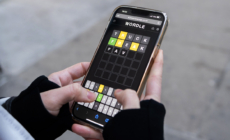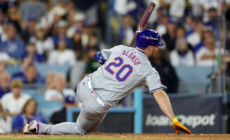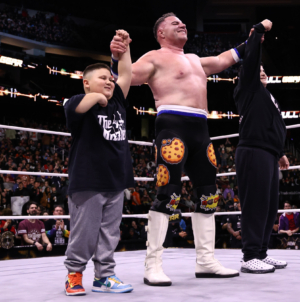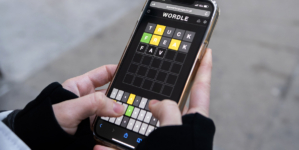-
Costco Guys More Popular Than Roman Reigns, Says Former AEW Superstar - 8 mins ago
-
Organized Looting Throws Gaza Deeper Into Chaos - 19 mins ago
-
Today’s ‘Wordle’ #1,283 Answers, Hints and Clues for Monday, December 23 - 43 mins ago
-
Artists We Lost in 2024, in Their Words - about 1 hour ago
-
John Cena vs Logan Paul ‘On The Table’ For WrestleMania 41: Report - about 1 hour ago
-
Ron Eliran, Israeli ”Ambassador of Song,” Has a Bar Mitzvah at 90 - 2 hours ago
-
Phillies Predicted To Cut Ties With Trade Acquistion Austin Hays - 2 hours ago
-
Mets Likely To Sign Pete Alonso Amid Depleted First Base Market - 2 hours ago
-
Trump Picks Callista Gingrich for Ambassador to Switzerland - 3 hours ago
-
NASCAR Cup Series Team Confirms 2025 Daytona 500 Entry Plans - 3 hours ago
Opinion | The Harsh Crackdown on College Protests Is A Dangerous Mistake
Two police cars idled across the street from the protest rally I was attending in front of the State Capitol in Austin, Texas, their red and blue lights flashing but their sirens silent. The police seemed more bored than annoyed. It was the early 2000s, and I had recently moved from Turkey to study at the University of Texas.
My fellow protesters were outraged. “This is what a police state looks like!” they started chanting.
I turned around, bewildered. Turkey was still emerging from the long shadow of the 1980 coup. For years, protests were suppressed, sometimes with deadly force. Even a whiff of disruption could get Istanbul shut down, with armored vehicles blocking major roads. Trust me, I said, this is not what a police state looks like.
When I told my friends back home that Americans thought it was outrageous for the police even to show up at a demonstration, it was considered yet more evidence that I had been recruited by the C.I.A.
“The American police showed up to a protest and did nothing?” one of my friends scoffed. “Just watched? No arrests? No heads bashed in?” Yeah, right.
In the two decades that have passed since then, American protests have changed a bit. America’s response to them has changed a great deal.
Many observers name Sept. 11 as the turning point when America’s police departments started becoming something more like a military force, but really, it was the Iraq War. That conflict turbocharged a policy that allowed police departments to get surplus military equipment at no charge. More than 8,000 local police departments have acquired over $7 billion worth of the kind of heavy equipment — mine-resistant armored vehicles, tactical gear, grenade launchers, weaponized aircraft, assault rifles — normally used in combat.
Why do places like Preston, Idaho (population 6,000), and Dundee, Mich. (pop. 8,000), need armored vehicles designed to withstand mines?
If you acquire it, it will likely be used. Police officers are a lot less likely to sit in cars and watch protests from a distance these days.
I stayed in academia and made political resistance around the world one of my primary fields of study. The one lesson I learned above all else is that a disproportionate crackdown is often a protest movement’s most powerful accelerant.
I saw it in Occupy Wall Street in 2011, when a video of penned-in women being pepper-sprayed at close range turned a little-known demonstration into an idea with nationwide reach. I saw it in Gezi Park, Istanbul, in 2013 when people hoping to save the park from demolition were tear-gassed and arrested, their small encampment burned. It helped generate protests that rocked the nation. I saw it in Ferguson, Mo., in 2014, when troopers showing up to a grieving community with armored cars and sniper rifles caused the outrage that fueled a national movement. And just think of what the photographs of police officers turning dogs and hoses on peaceful marchers did for the civil rights movement.
The United States now stands at another such inflection point. Across the country, university administrators — as well as some students, parents, trustees, donors and elected officials — have grown frustrated by protests over the war in Gaza. That’s no surprise; the protests are intended to be disruptive. Will authority figures rise to the moment and respond to the challenge with skilled leadership befitting institutions of higher learning? Or will they panic and enforce crackdowns way out of proportion to any actual threat?
It’s not looking good so far. At the University of Virginia, in Charlottesville, state police officers in riot gear carrying M4 carbines — the kind of weapons used in combat in Iraq and Afghanistan — and chemical-gas launchers were called in to disperse what many onlookers described as a small, peaceful group with a handful of tents. “None of these folks showed up when I lived on campus and white supremacists with tikki torches yelling ‘Jews will not replace us’ marched through campus as I hid my three kids,” Chad Wellmon, an associate professor at the university, wrote on social media.
At Dartmouth, police officers in riot gear were called in within hours after an encampment formed; in the ensuing confrontation they grabbed Annelise Orleck, the 65-year-old historian and former chair of Jewish studies, slammed her to the ground and arrested her. Until the Dartmouth community howled its objection, she was briefly banned from the campus where she had been teaching for 34 years. She still faces charges of criminal trespass.
At the University of Texas at Austin, officers in riot gear marched into campus on horses like the cavalry heading into war. At Indiana University, state police snipers were positioned on the roofs of campus buildings. Campus after campus is hosting similar scenes, including many pre-dawn raids on sleeping students. At Columbia University, an officer fired a gun. The N.Y.P.D. said it was an accident, and luckily nobody got hurt, but it’s not a comforting development.
It’s bad, and it’s getting worse. The ferocity of the crackdown exceeds the threat to public interest the encampments are accused of posing. It’s a violation of a longstanding social contract regarding how campuses handle demonstrations and a direct contradiction of the loving way that many colleges now depict campus activism of prior decades.
As hard as this may be to believe, absent the glare of publicity, these protests might have been unexceptional — the stuff of college life, for better or worse. Just last year, students at the University of California at Berkeley occupied a library slated for closing — bringing their tents, sleeping bags and air mattresses — for nearly three months. Congress didn’t see the need to hold hearings about it. In 2019, students at Johns Hopkins occupied a building for five weeks to protest the university’s contracts with Immigration and Customs Enforcement and its push for a private police force. Four students were arrested, but the administration quickly announced that the charges would be dropped. Why? Probably for the same reason that Police Chief Laurie Pritchett of Albany, Ga., once quietly arranged for the Rev. Dr. Martin Luther King Jr. to be released from the city’s jail — against King’s wishes. He knew the clamor would subside and the protest would roll on to the next city.
I saw the utility of this approach when I was studying in Texas. When first a few dozen and eventually roughly 200 University of Texas students occupied an administration building overnight to protest the end of affirmative action in the state, the school’s administration extended an olive branch: a series of town halls in which to discuss the issue. The offer was good only if the students left the building, and so they did.
It was a de-escalation tactic that also served as an educational experience. The discussions were sometimes charged, but they produced ideas that helped the university expand its strategies to maintain racial diversity. Those strategies helped the university achieve better results than many comparable institutions.
I hear many people say that the current protests have gone too far for such niceties.
When members of a university community feel threatened it’s a serious problem. Antisemitism is real (as is racism against Muslims and Arabs), and some of the protesters’ tactics, like blocking other people’s passage, have clearly crossed a line. Certainly students who’ve been identified making threats of any kind should face consequences. But the solution to problems like these does not arrive wearing riot gear.
The truth is, protests are always messy, with incoherent or objectionable messages sometimes scattered in with eloquent pleas and impassioned testimony. The 1968 antiwar protesters may be celebrated now, but back then a lot of onlookers were horrified to hear people chanting in favor of a victory by Ho Chi Minh’s army. During the Iraq war, I attended demonstrations to which fringe political groups had managed to attach themselves, and I rolled my eyes at their unhinged slogans or crazy manifestoes.
There’s plenty of that going on here, too. I’m not a wide-eyed graduate student anymore. I’m well into the get-off-my-lawn stage of my career (and until recently, my office overlooked the lawn where Columbia’s protesters pitched their tents). I, too, am often tempted to get annoyed at these students — why this slogan, why this banner, why not something with broader appeal? Overall, however, I’ve been impressed by the sincerity of the protesters I’ve spoken to.
Judging from the new encampments springing up around the country, the harsh countermeasures of the last couple of weeks are counterproductive. But more than that, they are dangerous. Overreactions like this can lead to social breakdown — on both sides of the barricade.
In 2014, Hong Kong’s democracy movement was a textbook nonviolent mass protest — the organizers even named their group “Occupy Central With Love and Peace.” Their movement was crushed, and many organizers were given lengthy jail sentences or forced into exile. I was there for the second round of protests, in 2019. The new leaders were so young and so earnest. As the police kept using rubber bullets and tear gas, though, a small portion of the participants stopped talking about love and peace and started making Molotov cocktails.
You can see where all this is going in the astonishingly violent attack at U.C.L.A., where a pro-Israel mob charged at people at the encampment with sticks, chemical sprays and fireworks. (The university and law enforcement did not intervene for hours.) And these dangerous dynamics can spread beyond campuses. On Wednesday, a man in New York was charged with assault, accused of driving his car into a crowd of people holding signs and chanting.
Overreaction is dangerous in another way, too.
The University of Florida has now said that students will be suspended from campus (and employees will be fired) for offenses such as “littering,” building “chairs” and posting “unmanned signs.” I somehow doubt that’s going to be applied to undergraduates taking a nap under a tree or to tailgaters at a football game. Rather, I suspect the point is to prevent protests the administration dislikes. What kind of precedent is that? The first bullet fired at a campus protest was an accident. I worry that the next one may not be.
Around the world, authoritarian leaders and others are watching these developments. The Turkish president, Recep Tayyip Erdogan, even issued a statement condemning the U.S. for its treatment of “conscientious students and academics including anti-Zionist Jews at some prestigious American universities.” I didn’t know how to react at first. But eventually I had to admit to myself that the comparison to a police state isn’t quite as outrageous as it once seemed.



















